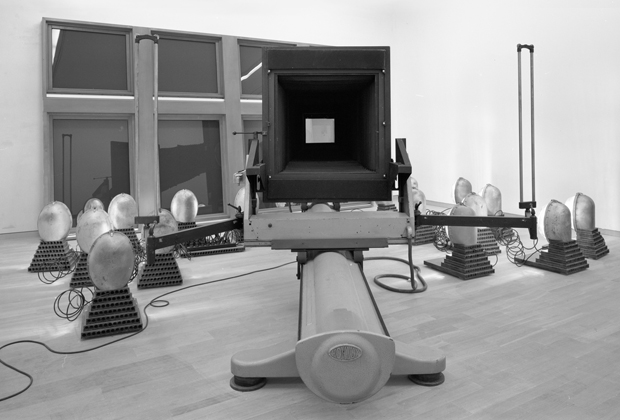
Curator Bogomir Ecker takes Fridey Mickel (and a crowd of curious senior citizens) on a concise yet personal tour of the AdK’s breathtaking contemporary sculpture retrospective ‘Lens-Based Sculpture’
It’s been a long time since Berlin has seen the kind of museum show where visitors queue for hours in line to get in. The last time arguably could have been back when the MOMA came to Neue Nationalgalerie 10 years ago. Lens-Based Sculpture should, by all rights, become one of those shows.
The show is an exquisite microcosm of contemporary sculpture in retrospect since 1920 that uses the central leitmotif of photography in sculpture. Starting with Umberto Boccioni and Raymond Duchamp-Villon (Marcel’s brother), it moves onto the more famous Duchamp sibling, helping the lay-person understand iconic works like “Bicycle Wheel 1913” without airy explanation. In the next space, the show takes on greater speed, moving quite quickly into the ever-more contemporary with the emergence of such sculptors as Bruce Nauman in 1966. Although there is no central piece in the show (it actually works like a mountain of stones – take one away and the whole constellation collapses), one recurring theme is Mr. Nauman, whose “The Space Under My Chair” serves as an introduction to the crucial relationship between sculpture and space.
Whether cornucopia or Pandora’s box is the better descriptor, its needless to say that this show is cool. At every turn there is some famous, key piece of sculpture plucked out of history to aid in the curators’ argument. A particular favourite was the plaster prototype of Auguste Rodin’s “Monument to Balzac”. It is considered the first truly modern sculpture, shedding light on the lengths to which the curators went to be inclusive – Ecker apologised for not being able to use the original, which is situated in the Boulevard du Montparnasse in Paris.
Richard Serra, Karin Sander, Kiki Smith, Charles Simmons, Jean Cocteau, Duane Hansen, Michael Sauer and Ecker himself – to name a minute few – are all here. A magical, vital tone is set, in which everything in the exhibition should be directly experienced without didactic explanation. Don’t miss out on it.
What was the starting point for this exhibition?
All sculptors whom I find interesting and important have, in a special way, something to do with photography. They are using photography as a tool of transformation. And they are more interested in the movement of this transformation, not on the formal image surface.
Space is a larger theme here in the exhibition (for instance, with Bruce Nauman’s “The Space Under My Chair”), but what role does the space of Akademie der Künste play?
Sculpture does not exist without space. The space situation in the Akademie der Künste demanded of Raimund Kummer and myself as sculptors (and as the show’s curators) a special form of presentation, which is modeled on the phenomena of the sculptures themselves. We developed an exhibition architecture which itself is very sculptural. Thus, the exhibition Lens-Based Sculpture can never again be seen in this form… Nevertheless, the exhibition will still move on to Art Museum Liechtenstein – in, of course, a completely different interpretation.
There are two little rooms inside the exhibition where the walls are adorned with images of the sculptures you weren’t able to get…
This is an image system of similarities and differences, in which the empty spaces that are missing images also gain meaning. The research is never finalised, things are further on the move and in current. Without the empty spaces, it doesn’t work.
Lens-Based Sculpture, through Apr 21 | Akademie der Künste, Hanseatenweg 10, Moabit, S-Bhf Bellevue, Tue-Sun 11-19
Originally published in issue #125, March 2014.


